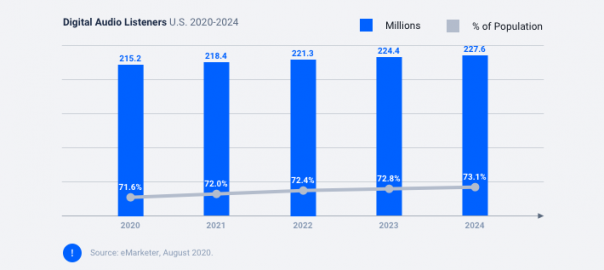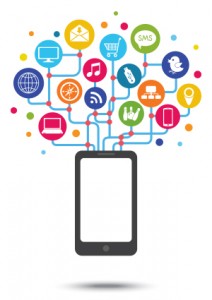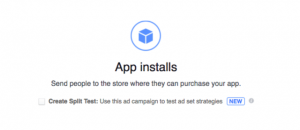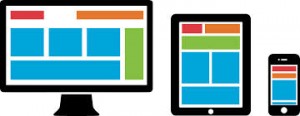In recent years there’s been rapid growth in audio content that’s available for streaming. Podcasts, audiobooks, music and playlists are all available to listen to through our mobile devices. This screen-free entertainment has quickly gained popularity. In 2021, 72% of Americans (218.4M) are listening to digital audio monthly. With programmatic audio advertising you can connect with this growing audience, right in their ears.
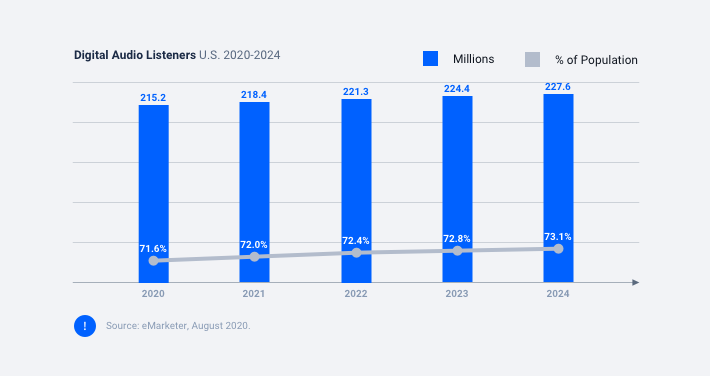
What is Programmatic Audio
Programmatic audio is programmatic advertising technology that automates the selling and insertion of ads into audio content, using a process similar to display advertising. With programmatic audio you can buy targeted ads from all the major audio publishers using one system. For example, it enables you to purchase ad space in the pre-roll, mid-roll, or post-roll of a podcast. Those ads reach listeners through various devices, including desktop, mobile, and tablet.
Audio advertising provides brands with the opportunity to reach audiences in screen-free moments in today’s highly mobile and connected consumer environment. But this isn’t the only benefit. Read on to learn 4 key advantages of digital advertising through programmatic audio.
Audio Advertising Is Emotionally Engaging
Unlike television and display ads, programmatic audio does not rely on visual engagement. Because of this, digital audio reaches consumers in an immersive way that visual advertising cannot. Music spurs emotions, and listening to a podcast can emulate the experience of chatting with a friend. Digital audio is so engaging that Edison Research reports that 70% of monthly podcast listeners don’t do anything else while listening to a podcast.
Digital audio commands the listener’s full attention in a way that other digital formats do not. This leads to listeners feeling intimately connected to the content they are hearing, which sets the stage for a better connection between a listener and a brand. When an ad comes on, a listener will be more receptive, which creates the opportunity to drive engagement. The personal nature of audio also results in ads having a lasting and memorable effect, which means a higher rate of ad recall.
Digital Audio Listeners Are a Valuable Audience
The fact that a large percentage of digital audio listeners don’t do anything else while listening makes them a valuable audience to target with programmatic audio advertising. Listeners typically aren’t engaging with other media, which means they won’t be distracted when they hear an ad. With their undivided attention, the ad will have more of an impact.
The added benefit is that the vast majority of audio ads can’t be skipped. There is no adblock tool for audio advertising, which means your ads will have a higher rate of exposure, earning the most out of your campaign budget.
The demographic characteristics of digital audio audiences also contributes to their value as an advertising target. The audience tuning into digital audio, particularly podcasts, is affluent: Edison Research found that podcast listeners typically have university level education, are employed, and earn a household income above $ 100k per year. This makes podcast listeners a valuable audience to target because with employment and financial stability, they are well positioned for general prospecting.
Another important demographic characteristic of digital audio listeners is age. Audio is popular among digitally savvy millennials and Gen Z. By targeting these age groups with programmatic audio, you have the opportunity to reach a younger audience that is entering, or is already in, their prime spending years. Moreover, by connecting with a younger demographic, you can form long-lasting relationships that with nurturing, will result in a higher CLV over time.
Audio Advertising Offers Unique Targeting Options
Targeting on programmatic audio is very similar to advertising channels you may already be familiar with. With programmatic audio, you can use the same audience targeting parameters from your native, display, video and connected TV (CTV) campaigns. But with programmatic audio, you have the option to fine tune your targeting even further. You can use data from audio partners to target specific genres, niches, and demographics. This way, you can match your ads to a mood, a genre, or topic.
There are many podcasts that fall into niche categories. When you browse podcast platforms you’ll notice categories like swimming, parenting, and crafts. This niche categorization further supports fine tuned audience targeting. Audio advertising on podcasts can therefore connect brands with consumers that have specified interests. For example, a fintech company might place an ad during a financial planning podcast. This ensures their ad reaches a relevant, well-aligned, and tuned in audience.
Conveying Your Brand Message Through Audio
With programmatic audio the bidding, buying, and campaign execution process works the same way as it does with other automated advertising. This makes it a natural addition to your digital advertising strategy. But the real value of programmatic audio is in the format of the ads. With digital audio advertising you communicate your message entirely through sound. This changes the way your brand’s message is conveyed and received.
Audio is emotionally engaging because unlike other forms of media, it’s often listened to with undistracted attention. A person might listen while walking, cooking, or driving—but they aren’t often using other devices. It is unlikely for someone to be watching TV while listening to an audio show. This makes audio the perfect medium for building brand awareness. And, programmatic audio will help with general prospecting and it will work in tandem with your other advertising initiatives like native ads, or video ads.
Digital & Social Articles on Business 2 Community
(75)
Report Post